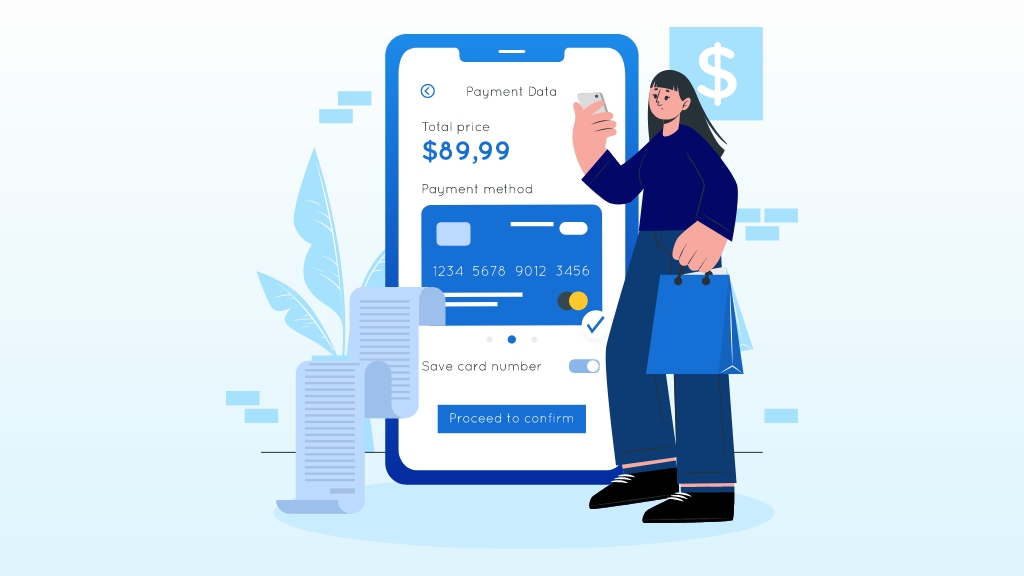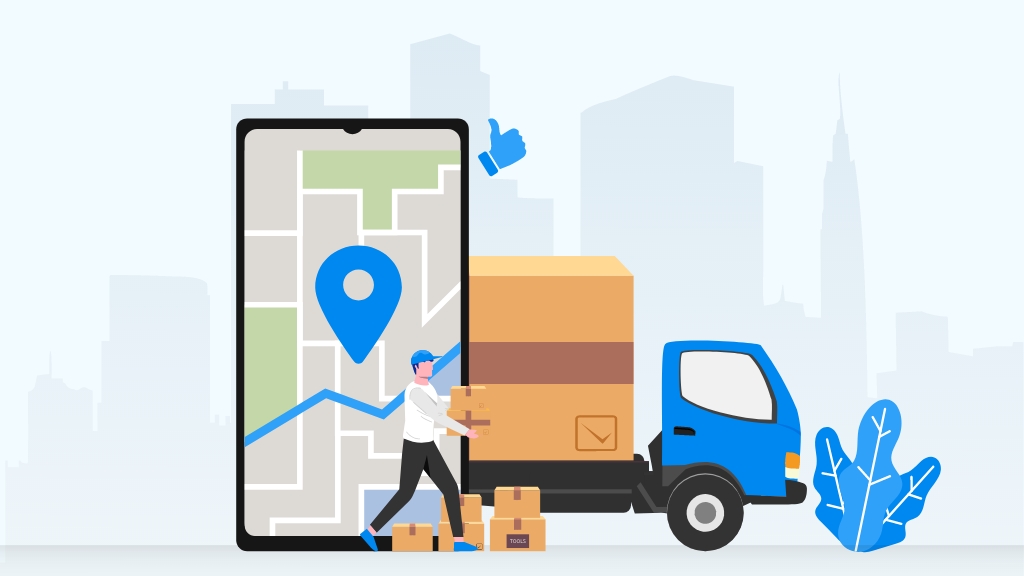Don't miss the chance to work with top 1% of developers.
Sign Up Now and Get FREE CTO-level Consultation.
Confused about your business model?
Request a FREE Business Plan.
A Quick Guide to Home Service App Development For Entrepreneurs
Table of contents
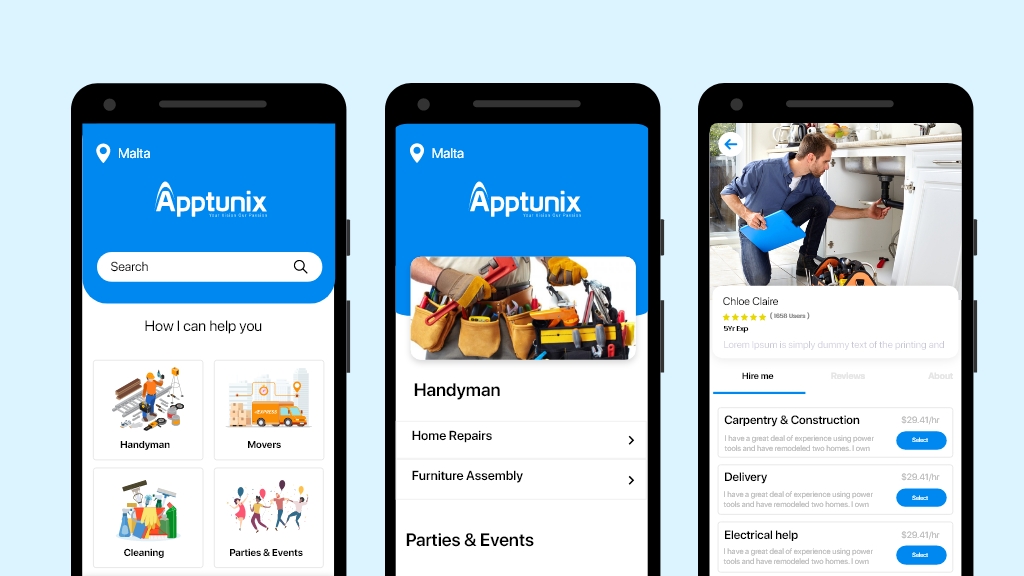
Imagine you are surrounded by stinky dishes in your kitchen, a messy room, some dirty clothes, and a lot of other stuff on the floor of your house. And look what, it is already 10:00 AM and you need to rush to the office.
What will you do? Cleaning?
No Way!
We are in the 21st century and have tiny angels in our pockets that can help us manage all these boring home chores while we can go out and do things that need our critical consideration. The innovators named these angels “Home Service Apps” and busy people around the world (like us) are so thankful they exist.
These apps not just enable people to cope with busy and modern lives to hire someone who can manage these tasks (cleaning, laundry, plumbing, and more) for them, but also provide many benefits to the service providers and home-service businesses.
That means a win-win situation for both the stakeholders!
So, if you are an entrepreneur who is planning any such venture or a home service provider who wants to expand or grow your business digitally – developing a robust on-demand home service app is an idea that can provide you various benefits. Let’s see how.
Here’s Why Home Service Apps Are the Need Of the Hour
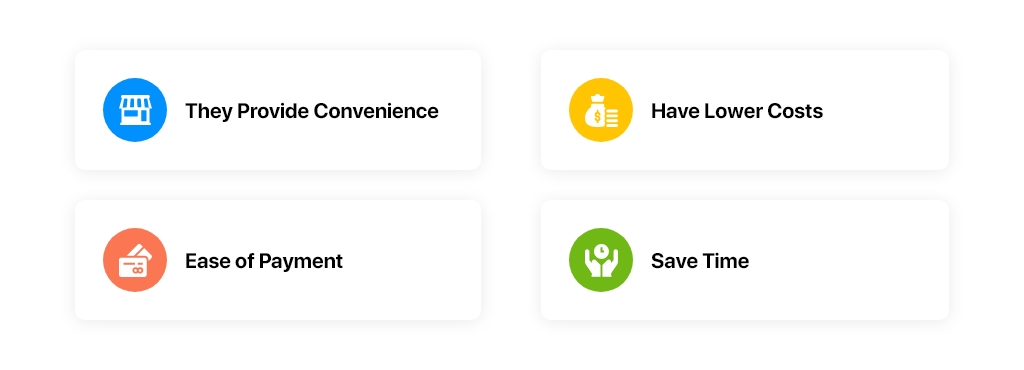
1. They Provide Convenience
Modern lives desire convenience and On-Demand Services provide the same. Apps like Urbanclap, Housejoy, and TaskRabbit are so popular because they provide all home-related services at one-platform which makes life easy for people around the world.
Users can browse different service providers, analyze them based on rating and reviews, hire someone as per their preferences, and pay for the services availed – all at one easy-to-use platform.
2. Home Service Apps Have Lower Costs
Cost is often the main driver for buyers. And on-demand home service platforms offer lower prices, compared to traditional providers. As a result, a number of home service apps are booming in the market.
3. Ease of Payment
Apps that provide home services act as a bridge between service providers and users. These apps often manage billing and payment transactions to help users pay in a single tap which future adds to their convenience.
4. Save Time
On-demand home service apps know what their users want. Therefore, they aim to deliver services as fast as possible and according to the user’s preferences. For instance, users can set a time limit during which they want to avail the service or they can get an idea of how much the service will cost them just by adding a few details.
While home service apps provide multiple benefits to users, they are also beneficial for service providers and home services businesses. If you are wondering why, here are some of the reasons that will help you understand its vital benefits so that you can make a better decision before you invest in its development:
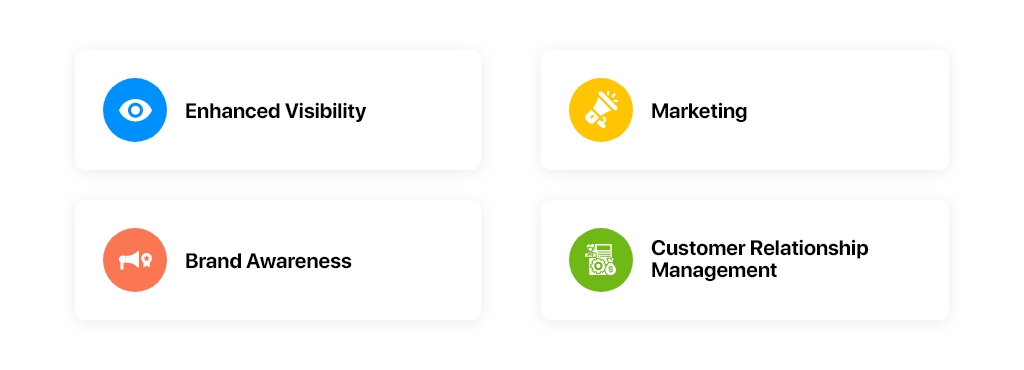
1. Enhanced Visibility
These days mobile apps not just keep your existing users hooked with your business but they also help in attracting new customers by increasing the visibility of your business. This in turn helps you scale your business. If you develop an on-demand home service app, you can 10X the visibility of your offline home service business.
2. Marketing
Mobile applications provide direct marketing opportunities for current and future users. These apps serve numerous functions like giving general information about services, booking forms, rates, search options, and more. This in turn helps businesses in marketing. Also, features like push notifications about discounts and deals available can help boost the sales of the business.
3. Brand Awareness
In today’s competitive world, it is of most extreme importance to use opportunities to instruct the target audience about your brand and build a powerful image of the same. A home service mobile app can help you do this by creating brand awareness.
4. Customer Relationship Management
One of the main advantages of mobile apps for businesses is the increased efficiency of providing customer care services. Using a home service app, you can resolve the queries of your customers in-app through chat or you can also integrate a chatbot in your mobile app that will provide 24/7 assistance to your customers.
Due to these benefits, the Home Service App Development market is flourishing significantly and the number of players in this market are increasing rapidly. Have a look at the following stats that tell a lot about the scope and demand of Home Service Apps.
Why Home Service Application Development Is a Billion-Dollar Idea?

Knowing all these stats, if you are planning to step into the home service app market, you must research everything about the industry and then enter it with a robust solution to immediately grab the market share.
In other words, you should be knowing all about the popular business models of the industry, how key players of the markets work and earn money, and what are their strategies to retain users and stay competitive in the market.
To help you navigate through the process, let’s first see the business models of the home service app market and then we will see the key players as examples of all types of business models.
Business Models of the Online Home Service App Market
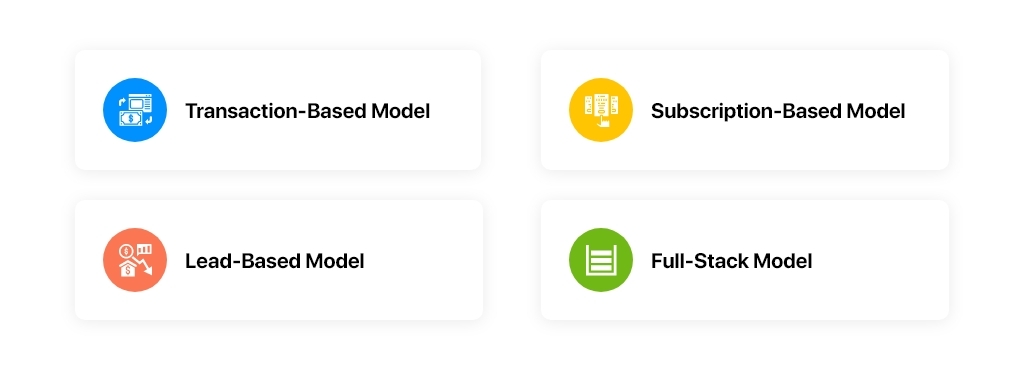
1. Transaction-Based Model
Using a transaction-based business model, home service apps take a percentage of every transaction that occurs through the platform. This model makes your platform more scalable – the more transactions occur, the more revenue you will generate.
For users as well, this model is beneficial as they pay only for the service they desire or need and service providers get the money only if they are hired. This drives both – customers as well as service providers to the platform, increasing credibility as well as supply.
2. Subscription-Based Model
This model suits well for platforms that offer services that don’t require a one-time fee. For example, regular household helps or cleaning services that users can avail by paying for them once a week/month.
From the end of service providers, this model is beneficial as chances of customer retention are very high while using it. On the other hand, from the perspective of a customer, this model takes the pain of booking services daily from their lives. Also, it helps them save costs as it is always costly to book service individually every day.
3. Lead-Based Model
Let’s understand this model with the help of an example.
Assume a customer needs his roof retiled and he goes to the home-service platform that uses the lead-based model. The app or platform will bring several professionals at one place who will bid for the task in hand after seeing its details. After seeing the bids, the customer will be able to choose the quote he likes the most.
This model is beneficial for all the three stakeholders – users, service providers, and the aggregator. While service providers will get the benefits of increased visibility in the market, customers will be able to make an informed decision by comparing costs from multiple providers. And the platform’s user base will grow faster comparatively using this business model as it will not charge customers for getting the quotes.
The increased user base in turn will attract more service providers to the app and hence you will be able to increase your revenue streams by proposing sponsorships to providers.
4. Full-Stack Model
Using this business model, the company relies on its own team members to accomplish the tasks at hand rather than depending on outsiders or partners. This model is beneficial (as the entire revenue will be yours) but a bit difficult to implement at the same time.
Now that you have seen how things work in the Online Home Based App Market – let’s put some spotlight on some of the Key Market Players of this industry to get some insight into their position in the market and strategies they use to stay competitive.
5 Key Players of the Online Home Service App Market
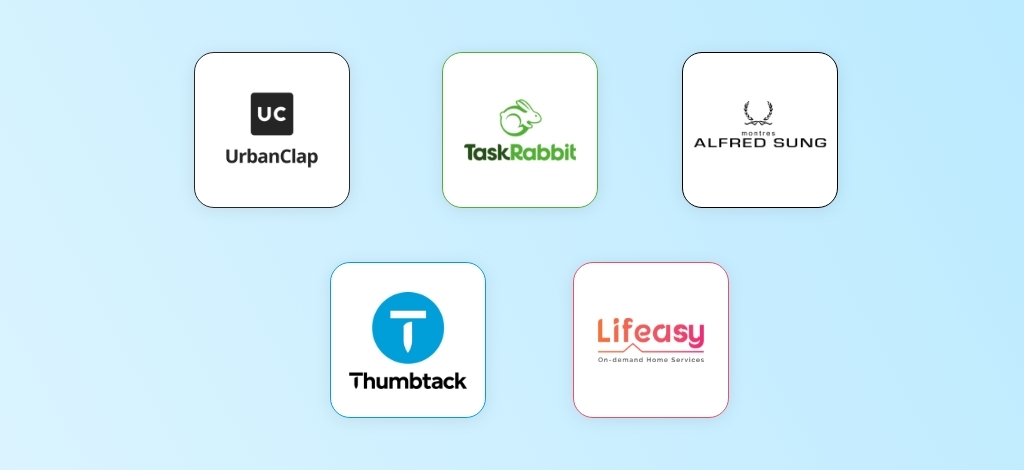
1. UrbanClap
UrbanClap provides multiple services on one platform. You can avail beauty services, home cleaning services, moving services, and more while sitting at your home using this app. The app operators using the Transaction business model and provides hefty discounts to its users to retain them.
Even after all these offers and discounts, the company earned a revenue of around Rs. 45 Crores in the year 2017-18. The company is able to stay competitive in the market because of its huge user base and variety of services provided by the platform.

2. TaskRabbit
TaskRabbit is a Boston-based application that was launched in the year 2008 as a need to aggregate those who were requiring services and the ones who wanted to earn extra by doing these simple home chores.
In around a decade, TaskRabbit has transformed itself from just an idea to a company worth millions of dollars. It has received over $40 Million in funding and boasts over 2 Million active users and thousands of service providers in around 40 locations in the USA and beyond. It was acquired by IKEA in 2017 and is currently operating as an independent subsidiary of IKEA using Transaction Based Model.
3. Alfred
It is a New-York based company founded by Jess Beck and Marcela Sapone in 2014. Alfred has received over $60 Million in funding and various awards and accolades. The app offers home management services and here customers are billed on a monthly basis and receive their service as per their convenience.
The subscription amount for each service is fixed based on its type, frequency, and rates of professionals that provide those service.
4. Thumbtack
Thumbtack has experimented with a transaction-based and subscription model before settling on a lead-based approach. Currently, professionals pay Thumbtack to contact users through credits, which they need to buy at the time of registration or whenever they feel like they need work.
Using Thumbtack, service providers just pay to quote customers and it doesn’t charge any commission for jobs that they complete or for further tasks that they get from the same customers and referrals.
With more than $200 million in funding since its launch in 2008, Thumbtack has been helping users find local service providers for their needs. By earning a small service charge for each offer, Thumbtack is able to stay competitive in the market by staying relevant to consumer needs.
5. Lifeasy
It is an India-Based home service app that kinda challenged the entire home service market by adopting a full-stack business model. The app relies on its own in-house team of professionals to accomplish the task at hand instead of depending on some other service providers.
The Indian home services market is said to be worth $100 Billion (approximately) with an average ticket size of $295 per household (per annum). And apps like Urbanclap and Lifeasy are taking immense benefits of this ever-growing market with their tremendous business models.
The choice of the right business model, its execution, your tech stack, and app designs, decide where your app becomes a hit or goes home. So, decide all of that very carefully. If you need help from our business analysts in taking the next big step towards turning your app idea into reality – you can get in touch with us! It is time to create your own venture!
While the market you are planning to enter is highly competitive – you can win it if you establish a home services start-up with an innovative idea that can be the next big disruptor. With the business elements already covered in the above sections – let’s now turn to the technical aspects of home-service apps and see what features you must integrate in your app to make it look more useful and enticing for users.
10 Must-Have Features of an Online Home Service Mobile App
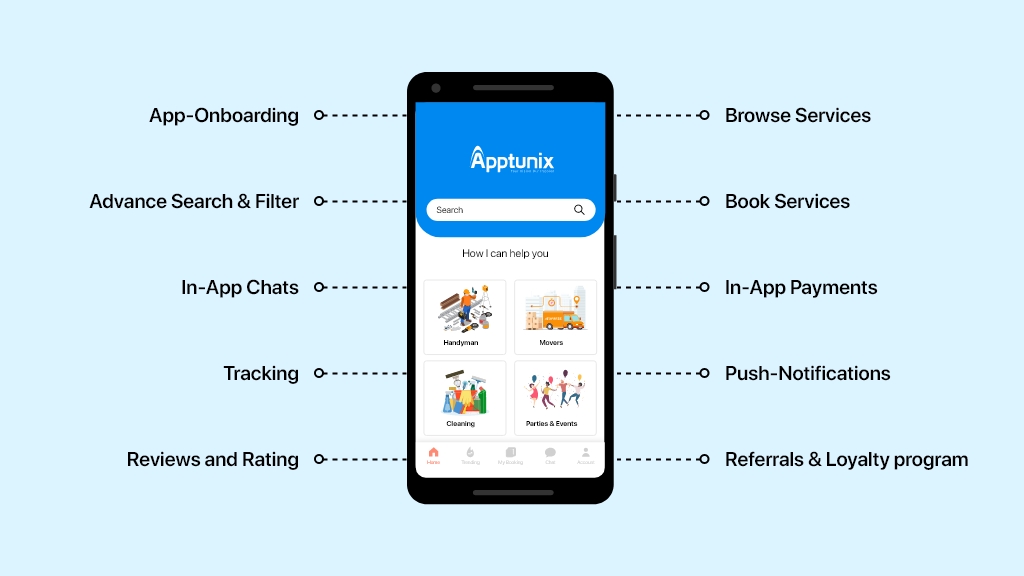
- App-Onboarding
This is the first thing that you will need to sort for your users to provide them a seamless experience. Keep this in mind that when using a home-service app, your users are looking for a solution or service to solve their problems. So, make sure they don’t get lost in your app.
You have to make the registration or sign-up, sign-in process as simple as possible for them to guarantee that your app provides a seamless user experience. Also, make sure to keep the navigation easy and simple so that users can find whatever they are looking for easily. A cluttered experience is something that no one desires!
- Browse Services
After a successful app onboarding process, a user must be presented with an opening screen listing all the services your app provides. When users click a particular service, the app should redirect them to a dedicated page for that service listing all the required details related to cost or per hour fee for the same.
- Advanced Search & Filter
While browsing feature is a must-have, you can not ignore to add advanced search filters in your app. Using these filters, users can find services they want to avail very easily.
- Book Services
This feature is helpful for both – users and service providers. Using it, users would be able to book a service to avail it instantly or to schedule it for later. You should also give them the option to reschedule the service if they are not available at the given time frame.
Using this feature, the service providers will be able to see the bookings that they have received with all their details in one place. You should also give them the leverage to accept or cancel a booking as per their availability.
- In-App Chats
To make your app a success, it is crucial that your users and service providers can interact with each other in real-time. And for this, the In-App chat feature is crucial. But, make sure that you give them a safe and secure platform to interact with each other.
- In-App Payments
While it is always recommended to give your users the option to pay for their orders in-cash, you should also give them the option to pay in a single tap by integrating in-app payment functionality. By letting your users pay in a tap – you give them one more reason to stay connected and engaged in your app.
- Tracking
You must give your users the ability to track your service providers so that they can know where they have reached, how soon they will come to the destination, and so on. This will end their anxiety and will help them plan for the visit accordingly.
- Push-Notifications
With app churn rate increasing day by day, push notifications play an important role in keeping users hooked to your apps. Not to mention – this feature can help you in a number of other ways as well.
Right from informing service providers about the order they received to winning back users who are no longer engaging with your app – push notifications feature is a win-win for all (users, service providers, and app owners).
- Reviews and Rating
Once the users take a service – they must be able to rate and review it depending on their experience. This feature is also extremely useful as it let app users choose service providers that have higher ratings
- Referrals & Loyalty program
Gamification is one such element without which no app can get success these days. Remember, your users have so many options when it comes to home service apps to choose from so it is your responsibility to allure and attract them towards your app. So, make sure you integrate one such feature in your app.
So now that you know all about Home Service Apps, how they work, their business models, and must-have features – its time to hit the ground running with your own mobile app. Let’s now see how you can do that.
How to Unlock the Billion-Dollar Potential of the Home Service App Market?
Just like the winning players mentioned above in this article – you too can reach the pinnacle of success if you approach the Home Service App Development process carefully with right tech partners. All you need to do is follow the below-mentioned steps:
1) Validate your app’s idea
2) Decide your business and revenue model
3) Make a list of the feature you want to add in your app
4) Approach an experienced Home Service App Development Company
5) Get it developed and boom!
You are all set to reap the benefits of hard work you will put into developing your app. However, make sure that you do not compromise with the user experience for some bucks. Keep in mind, you have to differentiate yourself from your competitors to stand out in this crowded market. The companies that invested in providing great service are ruling the home service market as of now and others are falling hard. So, approach the process very carefully!

Rate this article!
(10 ratings, average: 4.40 out of 5)
Join 60,000+ Subscribers
Get the weekly updates on the newest brand stories, business models and technology right in your inbox.

Nikhil Bansal is the Founder and CEO of Apptunix, a leading Software Development Company helping startups as well as brands in streamlining their business processes with intuitive and powerful mobile apps. After working in the iOS app development industry for more than 10 years, he is now well-equipped with excellent problem-solving and decision-making techniques.

Telemedicine 2.0 - A Comprehensive Guide On What Healthcare Providers Need To Know?
Discover how the latest advancements like Artificial Intelligence in telemedicine are reshaping patient care. This comprehensive resource offers insights into the key trends and innovations driving this shift, providing valuable knowledge for healthcare professionals looking to stay ahead.
Download Now!Subscribe to Unlock
Exclusive Business
Insights!
And we will send you a FREE eBook on 'Mastering Business Intelligence.
